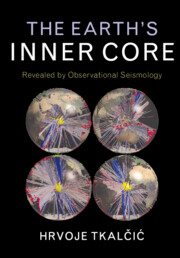Book contents
- Frontmatter
- Contents
- Preface
- Acknowledgements
- 1 On the History of Inner Core Discovery
- 2 Seismological Tools to Study the Inner Core
- 3 Inner Core Surface and Its Interior
- 4 Inner Core Anisotropy
- 5 Inner Core Rotational Dynamics
- 6 The Limitations, the Obstacles, and theWay Forward
- Appendix A Transmission/Reflection Coefficients for the Flat Inner Core Boundary
- Appendix B The Angle Between PKIKP Waves and the Rotation Axis of the Earth
- Appendix C P-Wave Velocity in a Transversely Isotropic Inner Core
- Appendix D Transdimensional Bayesian Inversion
- References
- Index
- Plate section
Preface
Published online by Cambridge University Press: 26 January 2017
- Frontmatter
- Contents
- Preface
- Acknowledgements
- 1 On the History of Inner Core Discovery
- 2 Seismological Tools to Study the Inner Core
- 3 Inner Core Surface and Its Interior
- 4 Inner Core Anisotropy
- 5 Inner Core Rotational Dynamics
- 6 The Limitations, the Obstacles, and theWay Forward
- Appendix A Transmission/Reflection Coefficients for the Flat Inner Core Boundary
- Appendix B The Angle Between PKIKP Waves and the Rotation Axis of the Earth
- Appendix C P-Wave Velocity in a Transversely Isotropic Inner Core
- Appendix D Transdimensional Bayesian Inversion
- References
- Index
- Plate section
Summary
“Every day is a journey, and the journey itself is a home.”
Matsuo Bashō, Narrow Road to the Interior (Bashō, 1694)In Jules Verne's novel, Journey to the Centre of the Earth (Verne, 1864), a forest of giant mushrooms grows on the shores of a large subterranean sea, ichthyosaurs and plesiosaurs clash for survival in its murky waters, and the heavy strata of the atmosphere permeates the gigantic cavern that must have somehow collapsed inwards from the surface. One and a half centuries later, our imagination for the deepest of the depths does not cease to exist and ‘the people of perpendiculars’, like Professor Lindenbrock from Verne's novel, whose only wish is to slide down the Earth's radius, are luckily still among us. Verne's phantasmagorical landscapes, however, get washed away by the scientific rigour of the deep Earth images that emerge from seismological studies. This is not to say that the Earth's centre in our contemporary view is featureless. Quite to the contrary, the inner core is a planet within a planet: a hot sphere with a mass of one hundred quintillion tons of iron and nickel that lies about 5150 kilometres beneath our feet, still waiting to be ‘discovered’. Its surface seems to be rough and mushy in places, and its interior deformed by internal stresses. It might contain heterogeneity at various scales, and host another smaller shell more elusive to our seismological probes. Despite its small volume (less than 1 per cent of the Earth's volume), the Earth's inner core contains about 10 per cent of the total magnetic field energy. It plays a crucial role in outer core fluid motions and the geodynamo, which generates the Earth's magnetic field. Without the magnetic field, life on Earth would be impossible. Embedded in the liquid outer core with a strong magnetic field and exposed to large gravitational pulling from the surrounding mantle, it spins faster than the mantle, and, at times, it slows down. But how do we know all this?
This book attempts to answer that question as it skips a significant part of ‘the journey’ and arrives by means of seismic waves at our destination – the inner core – right from the start.
Information
- Type
- Chapter
- Information
- The Earth's Inner CoreRevealed by Observational Seismology, pp. vii - ixPublisher: Cambridge University PressPrint publication year: 2017
